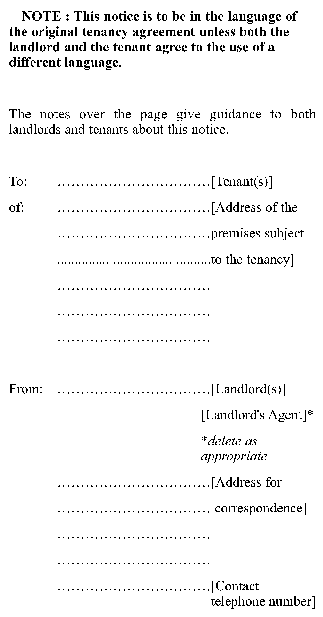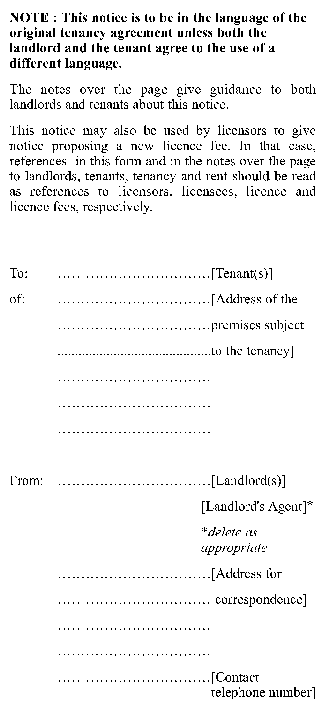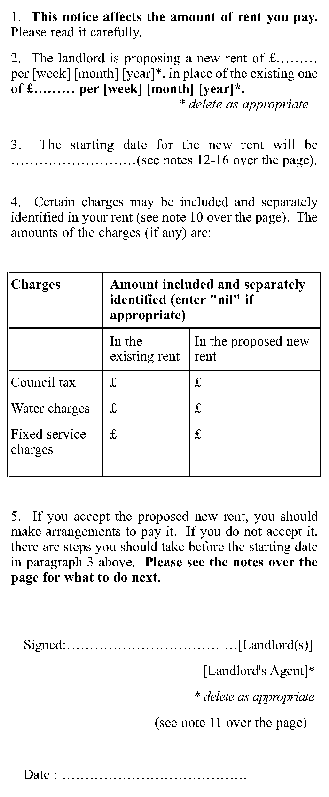- Latest available (Revised) - English
- Latest available (Revised) - Welsh
- Original (As made) - English
- Original (As made) - Welsh
The Assured Tenancies and Agricultural Occupancies (Forms) (Amendment) (Wales) Regulations 2003
You are here:
- Wales Statutory Instruments
- 2003 No. 307 (W. 46)
- Schedules only
Status:
This is the original version (as it was originally made).
Regulation 2(3)
SCHEDULEFORMS PRESCRIBED FOR THE PURPOSES OF SECTION 13(2) OF THE HOUSING ACT 1988
FORM No.4DHousing Act 1988 Section 13(2) as amended by the Regulatory Reform (Assured Periodic Tenancies) (Rent Increases) Order 2003Landlord’s Notice proposing a new rent under an Assured Periodic Tenancy of premises situated in Wales.
. Please read these notes carefully.
Guidance notes for tenants
What you must do now
1. This notice proposes that you should pay a new rent from the date specified in paragraph 4 of the notice. If you are in any doubt or need advice about any aspect of this notice, you should immediately either discuss it with your landlord or take it to a citizens' advice bureau, a housing advice centre, a law centre or a solicitor.
2. If you accept the proposed new rent, please make arrangements to pay it. If you pay by standing order through your bank, you should inform them that the amount has changed. You should also notify your Housing Benefit office, if you are claiming benefit. If you are worried that you might not be able to pay your rent, you should seek advice from a citizens' advice bureau or housing advice centre.
3. If you do not accept the proposed new rent, and do not wish to discuss it with your landlord, you can refer this notice to your local rent assessment committee. You must do this before the starting date of the proposed new rent in paragraph 4 of the notice. You should notify your landlord that you are doing so, otherwise he or she may assume that you have agreed to pay the proposed new rent.
4. To refer this notice to the local rent assessment committee, you must use the form Application referring a notice proposing a new rent under an Assured Periodic Tenancy or Agricultural Occupancy to a Rent Assessment Committee. You can obtain this from a rent assessment panel, housing advice centre or legal stationer (details can be found in the telephone directory).
5. The rent assessment committee will consider your application and decide what the maximum rent for your home should be. In setting a rent, the committee must decide what rent the landlord could reasonably expect for the property if it were let on the open market under a new tenancy on the same terms. The committee may therefore set a rent that is higher, lower or the same as the proposed new rent.
Guidance notes for landlords on how to complete the notice
6. You can complete this notice in ink or arrange for it to be printed.
7. This notice should be used when proposing a new rent under an assured periodic tenancy (including an assured shorthold periodic tenancy) of premises situated in Wales. There is a different notice (Form 4E — Landlord’s or Licensor’s Notice proposing a new rent or licence fee under an Assured Agricultural Occupancy of premises situated in Wales) for proposing a new rent or licence fee for an assured agricultural occupancy of premises situated in Wales.
8. Do not use this notice if the tenancy agreement contains a term allowing rent increases, or there is some other basis such as a separate agreement with the tenant for raising the rent. Any provision you rely on needs to be binding on the tenant. Legal advice should be sought if there is any doubt on this score.
9. You need to use a different form to propose a rent increase for a statutory periodic tenancy (the first exception mentioned in note 16) if you are seeking to adjust rent solely because of a proposed change of terms under section 6(2) of the Housing Act 1988. Seek legal advice if you think this may apply to you. You can obtain the form headed Notice proposing different terms for a Statutory Periodic Tenancy from a rent assessment panel or a legal stationer.
10. Unless the tenancy is a new one, or one of the exceptions mentioned in note 16 applies, you must insert in paragraph 3 of the notice the first date after 18th April 2003 on which rent was increased under this statutory notice procedure. That date determines the date that you can specify in paragraph 4 of the notice. See also note 15.
11. You should enter in each of the boxes in the second and third columns of the table in paragraph 5 either “Nil” or the amount of the existing or proposed charge. You should only enter amounts for council tax and water rates where the tenant does not pay these charges directly. You should only enter fixed service charges which are payable by the tenant in accordance with a term or condition which specifies that these charges will be included in the rent for the tenancy. Only enter an amount for service charges where the tenant has agreed to pay a fixed sum. Do not include in the table any variable service charge, i.e. a service charge within the meaning of section 18 of the Landlord and Tenant Act 1985, where the whole or part of the sum payable by the tenant varies or may vary according to costs.
12. You or your agent (someone acting on your behalf) must sign and date this notice. If there are joint landlords, each landlord must sign unless one signs on behalf of the rest with their agreement. The signature does not have to be hand-written if, for instance, the form is being printed or if you wish to use a laser or autosignature.
When the proposed new rent can start
13. The date in paragraph 4 of the notice must comply with the three requirements of section 13(2) of the Housing Act 1988, as amended by the Regulatory Reform (Assured Periodic Tenancies) (Rent Increases) Order 2003.
14. The first requirement, which applies in all cases, is that a minimum period of notice must be given before the proposed new rent can take effect. That period is:
one month for a tenancy which is monthly or for a lesser period, for instance weekly or fortnightly;
six months for yearly tenancy;
in all other cases, a period equal to the length of the period of the tenancy — for example, three months in the case of a quarterly tenancy.
15. The second requirement applies in most cases (but see note 16 for two exceptions):
(a)the starting date for the proposed new rent must not be earlier than 52 weeks after the date on which the rent was last increased using this statutory notice procedure or, if the tenancy is new, the date on which it started, unless
(b)that would result in an increase date falling one week or more before the anniversary of the date in paragraph 3 of the notice, in which case the starting date must not be earlier than 53 weeks from the date on which the rent was last increased.
This allows rent increases to take effect on a fixed day each year where the period of a tenancy is less than one month. For example, the rent for a weekly tenancy could be increased on, say, the first Monday in April. Where the period of a tenancy is monthly, quarterly, six monthly or yearly, rent increases can take effect on a fixed date, for example, 1st April.
16. The two exceptions to the second requirement, which apply where a statutory tenancy has followed on from an earlier tenancy, are:
where the tenancy was originally for a fixed term (for instance, 6 months), but continues on a periodic basis (for instance, monthly) after the term ends; and
where the tenancy came into existence on the death of the previous tenant who had a regulated tenancy under the Rent Act 1977.
In these cases the landlord may propose a new rent at once. However, the first and third requirements referred to in notes 14 and 17 must still be observed.
17. The third requirement, which applies in all cases, is that the proposed new rent must start at the beginning of a period of the tenancy. For instance, if the tenancy is monthly, and started on the 20th of the month, rent will be payable on that day of the month, and a new rent must begin then, not on any other day of the month. If the tenancy is weekly, and started, for instance, on a Monday, the new rent must begin on a Monday.
FORM No.4EHousing Act 1988 Section 13(2) as amended by the Regulatory Reform (Assured Periodic Tenancies) (Rent Increases) Order 2003Landlord’s or Licensor’s Notice proposing a new rent or licence fee under an Assured Agricultural Occupancy of premises situated in Wales.
. Please read these notes carefully.
Guidance notes for agricultural occupants
What you must do now
1. This notice proposes that you should pay a new rent from the date specified in paragraph 3 of the notice. If you are in any doubt or need advice about any aspect of this notice, you should immediately either discuss it with your landlord or take it to a citizens' advice bureau, a housing advice centre, a law centre or a solicitor.
2. If you accept the proposed new rent, please make arrangements to pay it. If you pay by standing order through your bank, you should inform them that the amount has changed. You should also notify your Housing Benefit office, if you are claiming benefit. If you are worried that you might not be able to pay your rent, you should seek advice from a citizens' advice bureau or housing advice centre.
3. If you do not accept the proposed new rent, and do not wish to discuss it with your landlord, you can refer the notice to your local rent assessment committee. You must do this before the starting date of the proposed new rent in paragraph 3 of the notice. You should notify your landlord that you are doing so, otherwise he or she may assume that you have agreed to pay the proposed new rent.
4. To refer this notice to the local rent assessment committee, you must use the form Application referring a notice proposing a new rent under an Assured Periodic Tenancy or Agricultural Occupancy to a Rent Assessment Committee. You can obtain this from a rent assessment panel, housing advice centre or legal stationer (details can be found in the telephone directory).
5. The rent assessment committee will consider your application and decide what the maximum rent for your home should be. In setting a rent, the committee must decide what rent the landlord could reasonably expect for the property if it were let on the open market under a new tenancy on the same terms. The committee may therefore set a rent that is higher, lower or the same as the proposed new rent.
Guidance notes for landlords on how to complete the notice
6. You can complete this notice in ink or arrange for it to be printed.
7. This notice should be used when proposing a new rent or licence fee for an assured agricultural occupancy of premises situated in Wales. There is a different notice (Form 4D — Landlord’s Notice proposing a new rent under an Assured Periodic Tenancy of premises situated in Wales) for proposing a new rent for an assured periodic tenancy (including an assured shorthold periodic tenancy) of premises situated in Wales.
8. Do not use this notice if the tenancy agreement contains a term allowing rent increases, or there is some other basis such as a separate agreement with the tenant for raising the rent. Any provision you rely on needs to be binding on the tenant. Legal advice should be sought if there is any doubt on this score.
9. You need to use a different form to propose a rent increase for a statutory periodic tenancy (the first exception mentioned in note 15) if you are seeking to adjust rent solely because of a proposed change of terms under section 6(2) of the Housing Act 1988. Seek legal advice if you think this may apply to you. You can obtain the form headed Notice proposing different terms for a Statutory Periodic Tenancy from a rent assessment panel or a legal stationer.
10. You should enter in each of the boxes in the second and third columns of the table in paragraph 4 either “Nil” or the amount of the existing or proposed charge. You should only enter amounts for council tax and water rates where the tenant does not pay these charges directly. You should only enter fixed service charges which are payable by the tenant in accordance with a term or condition which specifies that these charges will be included in the rent for the tenancy. Only enter an amount for service charges where the tenant has agreed to pay a fixed sum. Do not include in the table any variable service charge, i.e. a service charge within the meaning of section 18 of the Landlord and Tenant Act 1985, where the whole or part of the sum payable by the tenant varies or may vary according to costs.
11. You or your agent (someone acting on your behalf) must sign and date this notice. If there are joint landlords, each landlord must sign unless one signs on behalf of the rest with their agreement. The signature does not have to be hand-written if, for instance, the form is being printed or if you wish to use a laser or autosignature.
When the proposed new rent can start
12. The date in paragraph 3 of the notice must comply with the three requirements of section 13(2) of the Housing Act 1988, ignoring the amendments made by the Regulatory Reform (Assured Periodic Tenancies) (Rent Increases) Order 2003.
13. The first requirement, which applies in all cases, is that a minimum period of notice must be given before the proposed new rent can take effect. That period is:
one month for a tenancy which is monthly or for a lesser period, for instance weekly or fortnightly;
six months for yearly tenancy;
in all other cases, a period equal to the length of the period of the tenancy — for example, three months in the case of a quarterly tenancy.
14. The second requirement applies in most cases (but see note 15 for two exceptions). The starting date for the proposed new rent must not be earlier than the first anniversary of the date on which the rent was last increased using this statutory notice procedure or, if the tenancy is new, the date on which it started.
15. The two exceptions which apply where a statutory tenancy has followed on from an earlier tenancy, are:
where the tenancy was originally for a fixed term (for instance, 6 months), but continues on a periodic (for instance a monthly) basis after the term ends; and
where the tenancy came into existence on the death of the previous tenant who had a regulated tenancy under the Rent Act 1977.
In these cases the landlord may propose a new rent at once. However, the first and third requirements referred to in notes 13 and 16 must still be observed.
16. The third requirement, which applies in all cases, is that the proposed new rent must start at the beginning of a period of the tenancy. For instance, if the tenancy is monthly, and started on the 20th of the month, rent will be payable on that day of the month, and a new rent must begin then, not on any other day of the month. If the tenancy is weekly, and started, for instance, on a Monday, the new rent must begin on a Monday.
Options/Help
Print Options
PrintThe Whole Instrument
PrintThe Schedules only
Legislation is available in different versions:
Latest Available (revised):The latest available updated version of the legislation incorporating changes made by subsequent legislation and applied by our editorial team. Changes we have not yet applied to the text, can be found in the ‘Changes to Legislation’ area. The revised version is currently only available in English.
Original (As Enacted or Made) - English: The original English language version of the legislation as it stood when it was enacted or made. No changes have been applied to the text.
Original (As Enacted or Made) - Welsh:The original Welsh language version of the legislation as it stood when it was enacted or made. No changes have been applied to the text.
More Resources
Access essential accompanying documents and information for this legislation item from this tab. Dependent on the legislation item being viewed this may include:
- the original print PDF of the as enacted version that was used for the print copy
- lists of changes made by and/or affecting this legislation item
- confers power and blanket amendment details
- all formats of all associated documents
- correction slips
- links to related legislation and further information resources
More Resources
Use this menu to access essential accompanying documents and information for this legislation item. Dependent on the legislation item being viewed this may include:
- the original print PDF of the as made version that was used for the print copy
- correction slips
Click 'View More' or select 'More Resources' tab for additional information including:
- lists of changes made by and/or affecting this legislation item
- confers power and blanket amendment details
- all formats of all associated documents
- links to related legislation and further information resources




